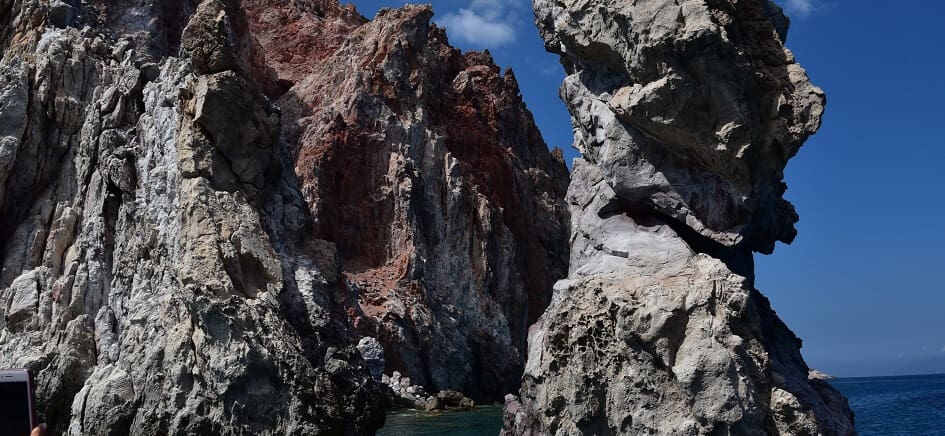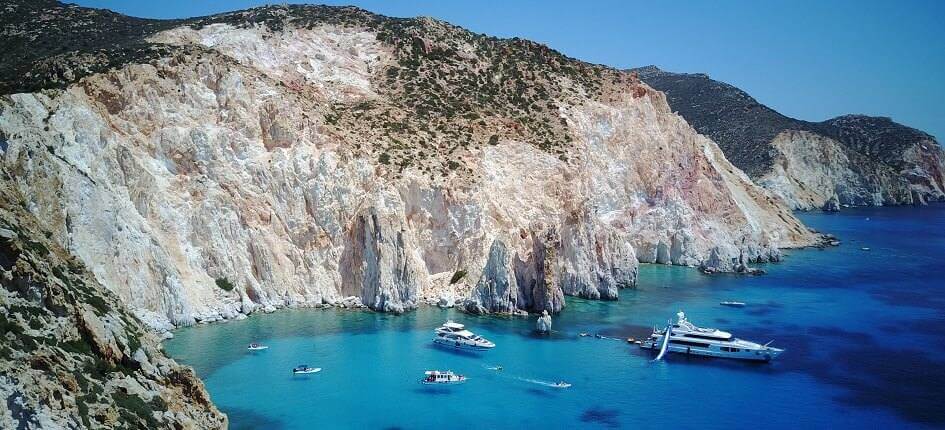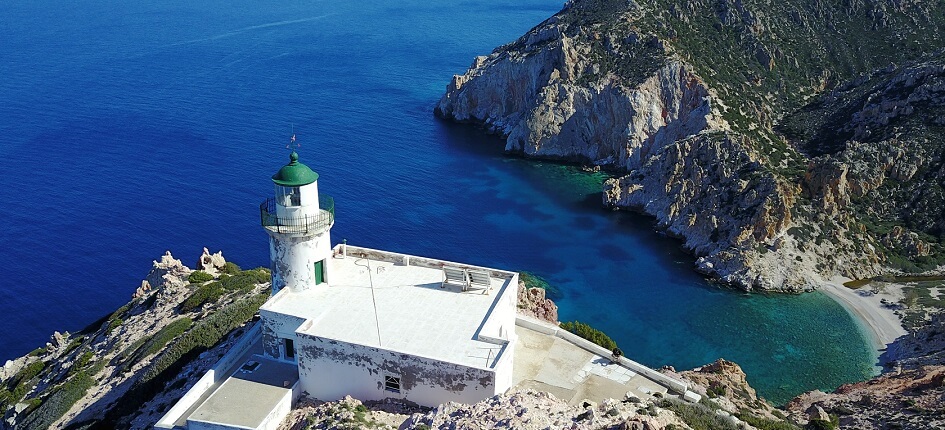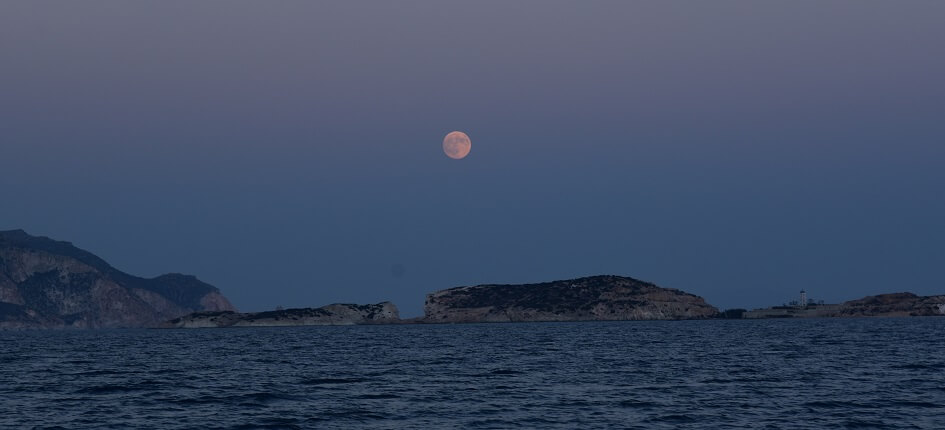- HOME
- ABOUT US
- ONE DAY EXPERIENCES
- BESPOKE JOURNEYS
- OUR STORIES
- PUBLICITY
- CONTACT US
Many goats or in other words Polyaigos
Search through website
Photo credits: Fotis Marinakis
Many goats or in other words Polyaigos
Destination:
Greece, Cyclades, Polyaigos
Date:
01.11.2020
We are Sailing
You are not going to read about livestock or animals here but about the largest uninhabited island in the Mediterranean Sea.
It’s called Polyaigos - and in my opinion, it’s also quite possibly the most beautiful uninhabited island in all of Greece.

The story of Polyaigos
You are not going to read about livestock or animals here but about the largest uninhabited island in the Mediterranean Sea. It’s called Polyaigos - and in my opinion, it’s also quite possibly the most beautiful uninhabited island in all of Greece. It hasn’t always been emptied of humans. Polyaigos was occupied during the Mesolithic or Neolithic era and has always been known for its mineral wealth. These days, it is mainly used as a pasture. Its name comes from “poly” which in Greek means many, or a lot, and “aigos” which means goats. Clearly, this beguiling rocky island was full of these four-legged creatures’ aeons ago, when Polyaigos got its name - but trust me, you will definitely see and hear them still when you visit.
The shape of Polyaigos
Polyaigos consists mainly of dramatically-shaped volcanic rocks and you can find hills up to 250-300 meters high. The geological contours resemble works of art! There are also photogenic man-made attractions such as the ruins of an old church and an impressive lighthouse (where rumour has it that one inhabitant lives off-grid over the last few years).

The nature
The island of Polyaigos is a member of the European Union's NATURA 2000 program, defined as an important region, without human presence, and subsequently, it has been declared a Special Protection Zone. There’s more to Polyaigos than goats. On the island, the Mediterranean Monachus-Monachus seal gives birth to its young, while one can also find, the blue lizard Podarcis milensis, the Falco eleonore hawk (Mavropetritis) and the Spitzaetos hawk eagle (Hieraaetus fasciata).

 Photo credits: Fotis Marinakis
Photo credits: Fotis Marinakis
Where is Polyaigos?
As you already know from previous stories, I am in love with the Greek islands and it is very hard for me to decide which is my favourite, as each one of them has its own individual beauty and character. But if we were to compare the splendour of the rocks, the caves and especially the brilliant colour of the sea (endless turquoise), then, Polyaigos is the winner! Actually, my personal interpretation of its name is “a lot of Aegean”;I substitute Aegean for goat, as the spelling is quite similar in Greek, and when you see it for yourself, you’ll agree: it is like God blessed this Aegean marvel. Polyaigos is a Cycladic island close to Kimolos, Milos and Sifnos islands and if you visit any of these places, hopping over to Polyaigos is considered an essential experience.
Setting sail around Polyaigos :
A must have experience
There is a good reason why so many serious yachties put Polyaigos on their bucket list. Sailing around the island of Polyaigos is a journey that you will not easily forget. It’s like witnessing a moving art gallery!
 Photo credits: Fotis Marinakis
Photo credits: Fotis Marinakis
Natural pools
As you approach the island, you will find deserted beaches, framed by natural pools, with blindingly blue waters - such as Ano and Kato Mersini, Panagia Avlaki with the poetic monastery of Panagia Odigitria and Ammoura, which you will probably decide is the most stunning of them all. Until you reach GALAZIA NERA - or azure waters, to give it its Greek translation! Imagine a Caribbean Blue Lagoon set against a volcanic white seabed and endless blue skies. The water’s mesmerising shade may look like someone has tipped gallons of dye into the sea, but in fact it’s created by the local clay - a prehistoric white chalk - that blends with the sand with such spectacular results. A rare beauty!
 Photo credits: Fotis Mainakis
Photo credits: Fotis Mainakis

Volcanic Rocks
You will have the chance to photograph various volcanic rocks that look like they were sculpted by the Gods themselves into gallery masterpieces (these striking stone statues also act as sleepless guards over the island of Polyaigos). You will also have time to swim in cathedral-like caves, climb the rocks, dive and explore the pristine waters with scuba diving masks.
The Lighthouse
Another wonderful spot is the natural port of Faros, with its lighthouse keeping constant vigil over the safety of all sailors. And of course, almost everyone encounters the famous residents of Polyaigos (the so-called wild goats of the island).
 Photo credits: Fotis Marinakis
Photo credits: Fotis Marinakis
The Cave
I predict that the highlight of your journey, however, will be Fanara (the cave without a roof), with its special beauty and graceful interior: you can spend a little time here to savour the setting and enjoy a tasty Greek snack!


Your captain for the day!
Your captain for the day is a unique host: a very experienced local seaman who will pamper you in hospitable Greek style as he introduces you to this amazing island of “many goats” or in other words Polyaigos. He will sail you very close to the rocks as he is intimately aware of every single reef in the area and he will drop you to different beaches for swimming, sharing colourful inside stories along the way about Polyaigos and the neighbouring islands. Polyaigos is not only recommended for swimming but also for snorkelling (your captain will provide you with all the necessary equipment).
Tips for your experience
I heartily recommend that you put aside a day of your holiday to visit breath taking Polyaigos during your stay in Kimolos. The ideal period would be June, July and September, when most visitors have left, especially if there is a full moon (you will enjoy its light and an illuminated view from the boat heading back to Kimolos). Needless to say, you can visit Poylaigos not only from Kimolos but from Milos and Sifnos too.
Book now a one-day experience of a round trip to Polyaigos and admire the island’s extraordinary gallery of rocks in all their different shapes and colours and the astonishing beauty of the blue waters all around them.

Gallery
Photo credtis:Fotis Marinakis

